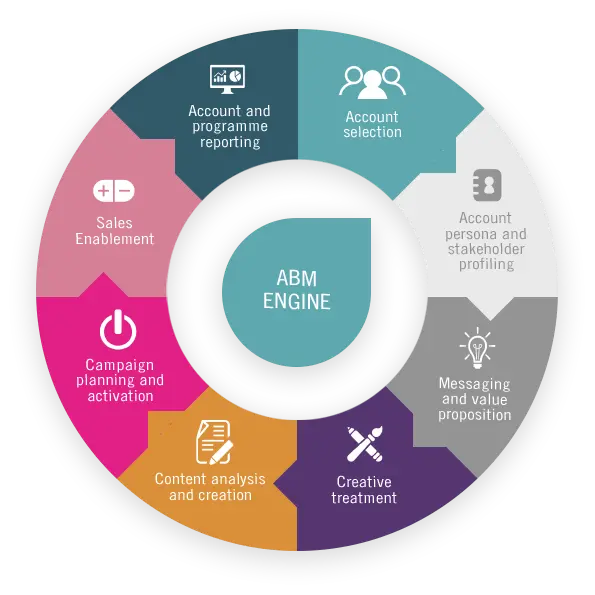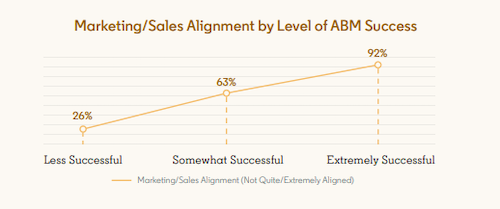ABM this. ABM that. Seems like all everyone does is talk about ABM. But it's for good reason. I mean ABM doesn't stand for awesome, brilliant marketing for nothing. Wait, what, it doesn't mean that?

With ABM, or Account-Based Marketing:
- Key business accounts are marketed to directly, as units of one.
- High value accounts are identified and key stakeholders are targeted. Specific marketing strategies are conducted through various channels to match specific needs and personas.
- There's a forced alignment between sales and marketing. Personalisation at the account level requires the two departments to be in sync, on account-specific messaging.
Moving from lead-centric to account based marketing means shifting your focus to a group of specific people within a specific company, over just throwing your line into a pool of unrelated prospects.
So, it's no good doing the same with your content. Personalised content is the perfect partner to personalised marketing. By delivering relevant content at the right time, you enhance the experience of your customer.
Content provides value to your target prospects, as well as your wider audience, over a long period of time. It can be reused, reused and recycled. So, you're saving money, time, and effort. Plus, content can be scaled in a way that supports your ABM campaign across the entire customer lifecycle.
Data from the account-based sales company Engagio shows that 75% of marketers cite an increase in close rates with account-based marketing. And, according to a recent survey by ITSMA Online Survey, ABM delivers the highest ROI of any B2B marketing strategy or tactic.
Looking for the down low from a download? Want to be overly-informed on ABM? Well, check out our ABM Platforms Best Practice Guide, here!
So implementing a content strategy gives you a leg up in reaching out to your dream customers. Right, then. How do you do it? Well, you can start by:
Doing the research
Easier said than done right? But the first step to take is to pinpoint your best accounts, and replicate them.

Figure out what makes your top-performing customers just that, and note the positives of their profile, such as their revenue, payment time, and implementation style.
Then, find out where they meet with similar industry profiles, such as trade shows and conferences, online groups, magazines, forums, social media, etc.
Doing this account-reliant research will help you create impactful content. So, ask yourself:
- Who are the decision makers?
- What are their pain points and desires?
- What content do they like to consume, and how do they do it?
Have a look at how they interact with content on social media, what they've been commenting and reacting to, and see how you can implement these elements into your own campaign.
It's also important to understand the people behind the accounts. Identify the decision makers within the accounts, and map their behaviours.
Learn about their habits and online activity, hobbies, professional life, digital communities etc. Then, you can compare this behaviour to their counterparts from other accounts, and see where the overlap is.

So, the next step is crafting specific content around these features.
Next step is going beyond just identifying the type of content each person is interested in. This means figuring out where in the buyer's journey they'll need to consume it. For example, the top of the funnel will usually be filled with less specific, more broad content.
But this doesn't mean it isn't personalised; the content should still speak to the specific buyer's pain points and desires, and the relevance of your product. Knowing who, and when, the content is made for requires a deep understanding of these different personas.
Capturing leads with targeted landing pages
A sneaky way to target leads is to use pillar pages as bait. In fact, companies that create 30 or more landing pages get 7 times more leads than those that use fewer than 10.
Basically, this means funnelling prospects to lead capture pages through targeted ad campaigns that advertise relevant and attractive content, which will then ask them to input contact details in return for the content. Tick, tick, you've got their details, and can begin the process.

So, all this means, first of all, providing content that helps solve your client's problem, to the point where they choose to click through. Your content, then, should prove some level of thought-leadership and expertise.
Also, identifying where your client's clicked through is just as important as getting them to do it in the first place. Based on the landing page, your sales and marketing teams can approach leads with a targeted and specific solution, based on their interests and issues.
This is why over 55% of content marketers use the pillar and cluster content strategy.
So, this means creating comprehensive pillar pages that explain the usage and benefits of your product or service, and how it will help your client. Then, branch out with relevant content, linking to and from this pillar page. These pieces should provide additional information and context behind the ideas and concepts.
Each pillar, therefore, can target a different decision maker persona.
Optimising your content process
Okay, this might sound obvious, but it's vital to get right.
In order to reach your target accounts, you need to keep your content relevant. And not only relevant, but regular, timely, correctly, and on the right platforms.
So, to make this easier on yourself, use content tools. This'll help streamline the entire process with some handy marketing automation.
In order to schedule social media campaigns you could use a number of different platforms or tools; Hootsuite, Buffer, Later.
Email campaigns also have tools available on the market; Mailchimp, Clickfunnels, ActiveCampaign.
Plus, make sure you have a tool like Wordable for easy document migration - content migration can reduce the speed at which you can deliver marketing campaigns.
Something else that will streamline your process is something that'll make auditing your content a breeze.
You need to audit your content in order to identify subject gaps, and to have a look-see at what content you currently have at your disposal. You might already have a bunch of content that's a good fit for the personas you're targeting.
Although, not all of your content will be useful in ABM. So, concentrate on altering, updating and personalising it to speak to your target stakeholders. Repurposing content to become more personalised, and ultimately more effective, will be time-saving and money-earning.
Pieces that meet the following criteria will serve as a good foundation for ABM content:
- Relevant to your key personas, or at least...
- …easily modified to be relevant to your key personas
- Visibly effective based on analytic score.
Working with sales
The sales and marketing alignment is vital in ABM. This is no different with your content.
.jpg?width=697&name=download%20(4).jpg)
The two teams must work together to provide a seamless experience for the clients, so the content created should have a place in both processes.
In order to help out sales, see where they are lacking assets to help them in their sales process. They'll have a deep understanding of the accounts on a personal level, and will know what type of content they need to facilitate positive conversations.
So, it's all about arming your sales team with helpful tools.
The relevant content will provide sales with the tools they need in guided conversations, and can act as value-driven offers to get the right response.
Sales can then guide them through the content and experience, elaborating on how it addresses their pain points and desires. It also provides nice, snappy communication between the stakeholder, and the other stakeholders within their company. If they can offer a piece of crucial data to their colleagues, you'll gain exposure and reputation across the account.
Great content will ultimately help your sales team deepen all-important relationships, and build sturdy connections with your target accounts.


